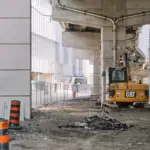A waist slab is a type of slab that is typically used in reinforced concrete staircases.
It is a horizontal structural element that connects the stair treads and risers, and provides support for the weight of the stairway and any loads that are placed on it. It is a like a ramp with steps.
The role of the waist slab in a reinforced concrete staircase is to transfer the loads from the stair treads and risers to the stairway’s supporting structure. The waist slab also helps to distribute the loads evenly across the stairway and helps to prevent the stairway from collapsing under heavy loads.

Typical components of a reinforced concrete staircase
In a reinforced concrete staircase, there are several key concepts that are important to understand:
Riser: The riser is the vertical face of each step in a stairway. It is the part of the stair that you step on when you’re going up or down the stairs.
Tread: The tread is the horizontal surface of each step in a stairway. It is the part of the stair that you step on when you’re going up or down the stairs.
Number of steps: The number of steps in a stairway is the total number of risers and treads that make up the stairway. You can calculate the number of steps required in a building by dividing the total difference between height with the height of one tread.
Also Read: Concrete Slab Calculator – Calculate Volume of Concrete in a slab and Mix ingredients
Going: The going is the horizontal distance between the front of one tread and the front of the next tread. It is the distance you step when you’re going up or down the stairs.
Like Us on Facebook!
Self-weight: The self-weight of a stairway is the weight of the stairway itself, including the weight of the risers, treads, and waist slab.
Subscribe Us on YouTube!
For the design of staircase, self-weight of waist slab is calculated as ______. Where, T = Tread, R = Riser and D = depth of waist slab, γc = density of R. C. C
To calculate the self-weight of a waist slab, you can use the following formula:
Self-weight =((Squareroot (Tread^2+ Riser^2))/tread) x Waist slab thickness) x Unit weight of reinforced concrete
Where:
Tread is the horizontal distance of each step
Riser is the vertical distance of each step
Waist slab thickness is the thickness of the waist slab
Unit weight of reinforced concrete is the weight of a unit volume of reinforced concrete.
It is also important to mention that when designing a reinforced concrete stair case, the design should comply with the building codes and regulations to ensure safety and durability of the structure.
Also Read: How to cut durock Cement Board? (Simple Steps)
Difference of waist slab and normal slab
A normal slab, on the other hand, is a flat, horizontal structural element that is typically used to create a level surface in a building or other structure. Normal slab are mainly used in the construction of floors, roofs, and other flat surfaces. They are typically thicker than waist slab and have a uniform thickness throughout their entire area.
The main difference between a waist slab and a normal slab is that a waist slab is specifically designed to support the weight of a stairway and any loads that are placed on it. It also has a specific shape, which is tailored to the shape of the stair treads and risers.
A normal slab, on the other hand, is simply a flat, horizontal surface that is used to create a level surface in a building or other structure. It has a uniform thickness throughout its entire area.
























